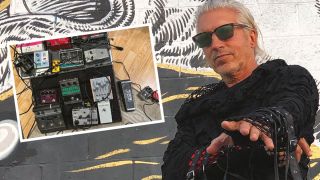“I have a small pedalboard that I use for fly-in dates. On that you’ll find a Klon, a second-year Malaysian chip [Ibanez Tube Screamer] TS808, a vintage script logo MXR Phase 90 and a Radial [Tonebone] Vienna Chorus. Luckily, I got the Klon before they went crazy expensive. It’s a beautiful thing to own, almost more for what it is than what it does.
“I actually use the Tube Screamer more, tightening up my Plexi for heavier rhythms. Say if I’m playing Tooth and Nail, I don’t want a floppy low-end. The TS808 sucks all that up, making it more defined and midrange-y. It probably sounds counterintuitive, but I don’t use my overdrives as much for leads as I do for rhythms. I might kick them in sometimes, like on Mr. Scary, which needs a bit more gain. Usually, I love hearing just the amp.
“On the larger ’board the main pedals include my Analog Man King of Tone, which I use sparingly for anything from that Robben Ford-ish world. It’s very thick-sounding and I run both sides at the same time, so one overdrive cascades into the other.
“There’s a mid-’70s [Electro-Harmonix] Electric Mistress, which was probably my main modulation sound up until the mid-’80s. It sounds very cool, pure ’70s! You can do the Hendrix thing or dial in Frank Marino-ish jet phasers. I actually got into them because it’s what Rick Derringer used in the ’70s. I saw him and had to get one. Pedals like this or the Mu-Tron Octave Divider tend to stay at home. They’re too big, too heavy and too noisy!

“I have a Hughes & Kettner [Tube] Rotosphere, which is built like a tank. There’s a 12AX7 tube in there, so you get that tubey preamp kinda thing. I love the brake on it where you can switch the speed like a real Leslie.
“I have two Fulltone Deja’Vibes. The red one is one of the first ever made, hand-painted when the guy was working out of his mom’s garage. I have the silver one because the red one doesn’t always work. It sounds maybe 10 percent less great. It does, however, work all the time!

“Other favorites include my Tone Bender fuzz. There were all sorts of variations over the years, each with different circuits. I believe this is a MK1.5 and the same version Jeff Beck used on Truth. There was his Les Paul, this pedal and a ’60s AC30 that was in the studio. That was the tone for the entire album… wow! It doesn’t sound like that when I play through it!
“The [EHX] Bass Microsynth is like a cross between the Mu-Tron and a Moog, with more variables like filter sweeps and voice mixes. It sounds massive, especially for Rage Against the Machine single-note riffs. Like a lot of the old EHX stuff, it works great but can be a one-trick pony. Other pedals I might use include a Jimi Hendrix Octavio, a Vox wah, a Univibe and a [Dunlop] Fuzz Face.”
If I had to choose only one pedal for a full show...
“Right now I’m using a Boss DD-500 for delay. I like it because it’s rock solid and has
a lot of classic sounds, including a Roland SDE-3000 preset, which is so good that,
in the heat of the moment, I honestly can’t hear or feel any difference.”
- Machine and Bone is out now via Frontiers Music.

